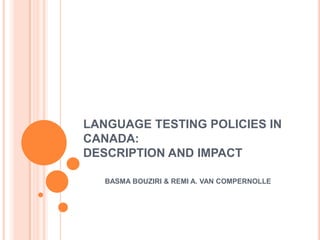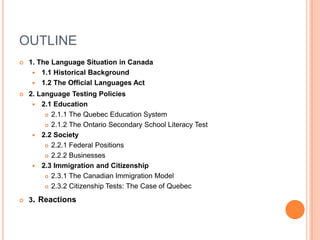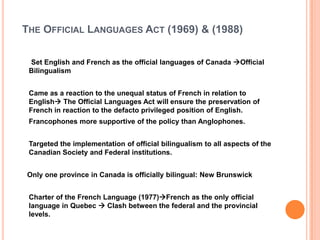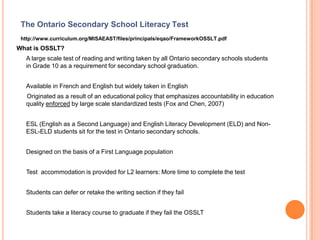Critical Language Testing In Canada
- 1. LANGUAGE TESTING POLICIES IN CANADA: DESCRIPTION AND IMPACTBASMA BOUZIRI & REMI A. VAN COMPERNOLLE
- 2. OUTLINE 1. The Language Situation in Canada1.1 Historical Background1.2 The Official Languages Act2. Language Testing Policies2.1 Education2.1.1 The Quebec Education System2.1.2 The Ontario Secondary School Literacy Test2.2 Society2.2.1 Federal Positions2.2.2 Businesses2.3 Immigration and Citizenship2.3.1 The Canadian Immigration Model2.3.2 Citizenship Tests: The Case of Quebec3. Reactions
- 3. The Language Situation in Canada
- 4. Historical BackgroundColonization (started early 16th century)Canada (England)New FranceSeven Years War (European war played out in N. Am.)1755: French-speaking Acadians deported by English1759: Gen. James Wolfe (English) invades Quebec (the city/fort); defeats French army led by Louis Joseph de Montcalm1763: Most of N. Am. under British controlEnglish Canada dominates socially, economically, and politically until 1960s (Quiet Revolution)Since 1960sLinguistic legislation in QCFrench language revitalizationQuebec independence movementHostilities between Anglophone and Francophone CanadaQuebec Identity Act (2007)
- 5. The Official Languages Act (1969) & (1988) Set English and French as the official languages of Canada ’āĀOfficial Bilingualism Came as a reaction to the unequal status of French in relation to English’āĀ The Official Languages Act will ensure the preservation of French in reaction to the defacto privileged position of English.Francophones more supportive of the policy than Anglophones. Targeted the implementation of official bilingualism to all aspects of the Canadian Society and Federal institutions. Only one province in Canada is officially bilingual: New Brunswick Charter of the French Language (1977)’āĀFrench as the only official language in Quebec ’āĀ Clash between the federal and the provincial levels.
- 6. Language Testing Policies In Education
- 7. Quebec Education SystemEducation in French (since 1977, la Loi 101)All Quebeckers and immigrantsAnglophone Canadians (from outside QC) and Fist Nations can opt to send children to English schoolsEnglish taught as L2 (since 2006)Early immersion available in some schools
- 8. The Ontario Secondary School LiteracyTest http://www.curriculum.org/MISAEAST/files/principals/eqao/FrameworkOSSLT.pdfWhat is OSSLT? A large scale test of reading and writing taken by all Ontario secondary schools students in Grade 10 as a requirement for secondary school graduation. Available in French and English but widely taken in English Originated as a result of an educational policy that emphasizes accountability in education quality enforced by large scale standardized tests (Fox and Chen, 2007) ESL (English as a Second Language) and English Literacy Development (ELD) and Non-ESL-ELD students sit for the test in Ontario secondary schools. Designed on the basis of a First Language population Test accommodation is provided for L2 learners: More time to complete the test Students can defer or retake the writing section if they fail Students take a literacy course to graduate if they fail the OSSLT
- 9. The Ontario Secondary School Literacy TestL2 Performance on OSSLTCheng, Klinger, and Zheng (2007) reported: Lower performance of L2 in relation to L1 test takers across reading text types, skills and strategies and the writing tasks.ŌĆ£Alarmingly high failure rates for L2 studentsŌĆØ ’āĀ In 2002, 63% of L2 students failed at least one component of the testDropout rates 52% in 1999
- 10. The Ontario Secondary School Literacy TestValidity and Ethical Issues with OSSLTIs it measuring literacy or language proficiency?Fox and Cheng (2007 Students could not understand the prompts ’āĀ Left answer fields blank. Students could not understand some concepts: ŌĆ£Junk foodŌĆØ Which ŌĆ£meaningsŌĆØ does it test?Cheng, Klinger and Zheng (2007) The narrative reading text type, the indirect understanding reading skill and the vocabulary reading strategy were found to be the best discriminators between ESL/ELD and non ESL-ELD students’āĀ Tests knowledge of culture: items that have the more embedded social and cultural conventional meanings are the more challenging for L2 learners.
- 11. The Ontario Secondary School Literacy TestOSSLT AccountsFox and Cheng (2007) focus group accounts on the OSSLTŌĆ£Just give this to me in Chinese and IŌĆÖd be able to do it in a minuteŌĆØŌĆ£Why when we use our dictionaries everyday in classŌĆ”why canŌĆÖt we use them on the testŌĆØŌĆ£We donŌĆÖt want more time. We want to be treated like all the other students ’āĀ Awareness they belong to a different membership category.
- 12. Language Testing Policies in Society
- 13. Federal EmploymentCompetence in English and FrenchCELPIP (Canadian English Language Proficiency Index Program)Test de connaissances du fran├¦aisMost Anglophone Canadian ŌĆ£proficientŌĆØ but not functional in FrenchMost Francophones (30s and younger) bilingualEnglish remains primary language of federal governmentMilitaryOfficial bilingualismOfficers must be able to give order in English and FrenchSeparate Anglophone and Francophone units
- 14. The Quebec Language Police: Another form of Testing is MonitoringLimited services in English in QuebecSome health and social services institutions with 50% of its staff as non French speaking are allowed to use English internally’āĀ Compare to: 20% in New Brunswick and 10% in OntarioEconomic sanctions based on language ’āĀ Corporations of a certain size will not receive subsidies if their non French speaking employees do not have a francization certificate.
- 16. ImmigrationA point system where language is one factor of selection. http://www.immigrate.net/law/en/Visaslaws/PointSystem.aspKnowledge of one of the official languages gives you points depending on your proficiencyQuebec requires immigrants to sit for the Test de Connaissance du Francais (TCF)CELPIP (Canadian English Language Proficiency Index Program) for Anglophone Canada
- 17. Canadian CitizenshipQuebec Identity Act (2007) A person is a Quebec citizen if they have an appropriate knowledge of the French language; and appropriate knowledge of Quebec. Canadian citizenship test developed by the centre for Applied Language Studies.Citizenship administered in English and French’āĀ Test language skills in addition to knowledge.
- 19. ReactionsLanguage Fairness in Canada. Facebook GroupŌĆ£Sunday's column suggested, in a light-hearted way, that Ottawa is home to legions of bureaucrats who have faked their way through to bilingual status -- not fluent in any meaningful sense -- but able to pass a test.ŌĆØESSO in Quebechttp://www.youtube.com/watch?v=Q_iTDjpsU_g&feature=relatedEarly French Immersion http://www.youtube.com/watch?v=BdzpBmt09m8
- 21. ReferencesCheng, L., Klinger, D. and Zheng, Y. (2007). The challenges of the OSSLT for second language students. Language Testing, 24. Fox, J. and Cheng, L. (2007). Did we take the same test? Differing accounts of the OSSLT by First and Second Language test-takers. Assessment in Education, 14: 1. The Official Languages Act. Retrieved July 11, 2009 from http://laws.justice.gc.ca/PDF/Statute/O/O-3.01.pdfQuebec Identity Act (2007)





















